By Natalia Vasquez
Eric Verduzco
A thick scattered group of clouds race the Monday commuters home for a hot dinner, diving over one another in clusters that intertwine in delicate yet aggressive patterns. Nobody enjoys the first day of the workweek, and any interference with its commencement snowballs from mildly inconvenient to Guantanamo scaled torture. Now, Bay Area nine-to-fivers must deal with BART service disruptions each and every one of these horrific days.
“I get it, they made their point, but I didn’t shoot anybody and I just wanna get home,” the perfectly styled petite Jamie Arias huffs from her Market Street store Juicy Couture. She lives in Antioch and after working a full shift she returns home to a husband and two daughters who rely on her “to handle all the Mom stuff,” like prepping dinner or balancing the family budget. “And I certainly can’t leave my husband in the kitchen unattended,” she mouths with glossy rose lips and sarcasm in equal shades of hot pink.
When Charles Hill was shot on July 3, 2011 the BART police immediately evacuated all civilians from the area, according to witness Alexander Monsanto. “I heard the shot but I didn’t notice any yelling or struggle before that,” he recalls the sound ripping through the static of the bustling UN Plaza just as the bullet ripped through Charles Hill’s vital organs.
Security footage later shows the officer emerging from a BART train and taking less than one minute to remove his gun from the holster. It was only six more seconds before he opened fire on Charles Hill.
Chief of Police Kenton Rainey would later comment he was completely satisfied with officers’ responses.
“There were people screaming, and running, and nobody knew what had really happened but it went from zero to chaos just like that,” says Monsanto, his full lips part enough to reveal his teeth as his eyes scan to and fro while he replays the scene in his head.
A press conference the following day attempts to relay the events. Chief of Police Kenton Rainey explains that they were responding to complaints of a drunk man with an open container on the platform. The officers who arrived first acted to the best of their abilities, according to Chief of Police Rainey. They were placed on administrative leave until a psychologist could properly evaluate them. Rainey brushes over exact details between the officers and Charles Hill, only that Hill was armed with a bottle and a knife. He explains that because of the open investigation he cannot say anything specific. An open investigation by BART’s own criminal division, coupled with an investigation by SFPD.
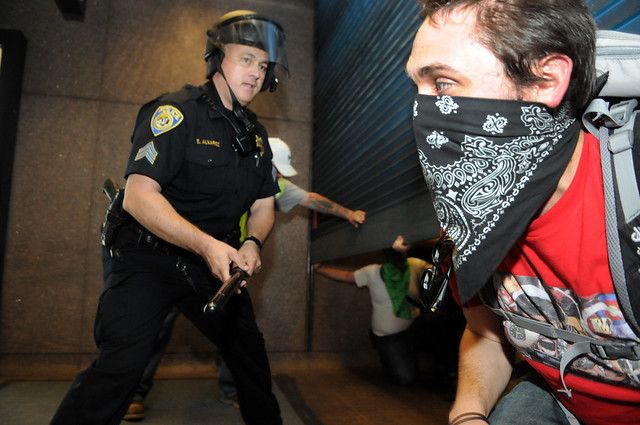
On July 11 the people responded by taking to the streets. People enter into the stations, behind the fare gates and chant to disband BART police. One person even jumps on top of a BART train to keep it from departing the platform. They hold open train doors so they wont be able to depart, and clog the platform so customers cannot board. YouTube video shows frantic personnel trying to handle the situation, but to no avail.
The horde of people not only takes over trains, they take over the streets. People walk in the center of Market Street during rush hour, slowing traffic and potentially harming themselves. Some approach police officers shouting obscenities. They chant in loud echoes reverberating through buildings of commerce, “you can’t shoot us all!”
This delays the evening commute which, according to a BART press release, delayed ninety six trains “putting at risk the safety of thousands of passengers and BART employees.”
On July 12, BART holds a meeting to review their police department. Members of the public are present to make comments to the committee comprised of BART directors. One man asks about gun training BART officers receive, citing previous incidents of unnecessary violence. Annette Sweet, a member of BART’s board of directors, explains that BART police now undergo an additional sixteen hours of training every year and Rainey explains they must qualify at a gun range every two months.
BART officials fail to cite non-violent training or civilian training, only a gun proficiency screening.
Krystof Lopaur of No Justice No BART takes the mic. Lopaur has advocated to disband BART police prior to this incident and the board knows him well. He demands to hear how a transit agency manages a police force and what kind of management training they have undergone. The answer is none. Although, board members did undergo training to shoot.

Lopaur also points out that while protesters and personnel alike were outside the safety areas of train platforms, BART continued to run trains through stations without stopping at top speeds, “putting at risk the safety of thousands of passengers and BART employees.”
Lopaur’s message is simple, disband the BART police because a transit agency does not have the training to handle a police force, as demonstrated by these casualties. He warns that if nothing is done, things will not quiet down.
In mid August rumours of another protest began circulating. The threats claim people would take to the streets with more force and bigger disruptions. They threatened they will be larger than the incident on July 11, and warn BART to prepare for them. And prepare they did.
BART, in a press release on their site maintained safety as their ultimate goal. “A civil disturbance during commute times at busy downtown San Francisco stations could lead to platform overcrowding and unsafe conditions for BART customers, employees and demonstrators. BART temporarily interrupted service at select BART stations as one of many tactics to ensure the safety of everyone on the platform.” As emails obtained through the Freedom of Informations Act points out, BART took action prior to imminent threats of danger on the platform. Officials acted several hours before any sort of “unsafe conditions for BART customers” were underway.
The largest organizational tool, much like in the Arab Spring, continues to be social media. The people garnish this technological tool to organize and gain solidarity across the Bay Area and to stand up for the minority class.
Dirk Peters contacts BART business partner Forza Telecom and Wifi Rail Inc. to eliminate cell phone and internet service on August 11 from 4pm to 8pm, according to emails. Peter’s emails were sent at 8:45 am, well before any disruptions. When the anticipated hour arrived, the BART was empty of any protesters and merely disconnected commuters.
BART had also planned its own press conference and what has been called publicity stunt to shuttle customers to and from a press conference intended to sway public opinion of the transit agency according to emails obtained by The Bay Citizen. Linton Johnston orchestrated the ordeal and even prepared a script for “loyal customers” to read at the conference which read among other things, that their life felt as risk. Only one rider attended.
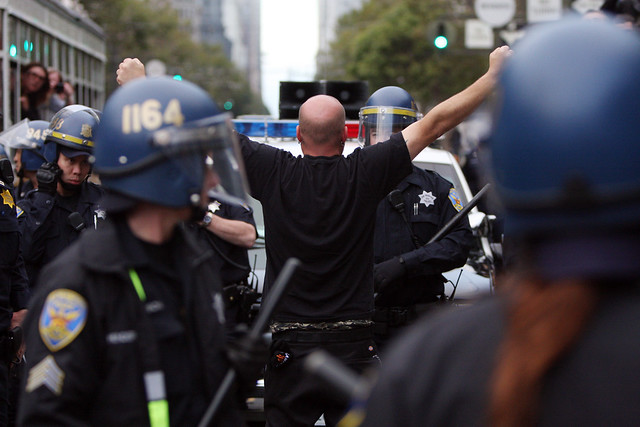
As Chris Battle writes for the blog Security Debrief, “whatever action BART did take should have dealt with the actual protest and not with the lines of communications used to organize it. Law enforcement must become more intelligent in its reaction to social media. And that’s what it is, reaction.” Battle writes about security and politics of Homeland Security and a partner in leading Homeland Security strategic communication practices. “What law enforcement really needs to do is proactively educate itself on social media and learn to use it to its advantage in a positive way.”
Al Jazeera points out that because the BART tunnels would not have Wi-Fi or cell phone service. The technology services are merely a luxury provided to customers, putting the policy in a legal gray area. Linton Johnson, BART’s communication representative, cited a 1969 Supreme Court ruling as justification.
After the cell shut down people struck back harder than ever. Demonstrators cover their faces and march from the Embarcadero up Market Street. They are many, and their voices demand justice for the seven lives BART police have claimed since the 1970s.
“They say they’re here to protect and serve us, but BART police just make me nervous!” the mass of masked men and women chant. Many are wearing faux blood stained shirts in honor of the blood shed by the victims.
“We are all Oscar Grant! We are all Charles Hill!” they cry as signs demanding justice for the deceased thrust towards the sky. Their message is clear, they want BART police to disarm and disband before more lives are claimed.
“I wonder why they didn’t shoot for his arm or his legs,” writes Hill’s physician, Dr. Rupa Marya, in a letter published by the Bay Guardian. She only remembers Hill as a pleasant person suffering from substance abuse.
Krystof Lapour maintains this has to do with an underlying class war that is inherent in the BART police model. Because they are serving paying customers, they set up clear boundaries for whom they will ultimately protect and serve. This class war was left out of the media, who framed the story much differently than BART surveillance and witnesses remember it.
Many news corporations framed the scene as a violent drunken homeless man advancing toward police armed with knives.
While somewhat accurate, Hill having often been at some level of intoxication and also having knives on his person, witnesses recall him holding an unbroken bottle but not necessarily wielding it at the officers. One witness, Melyssa Jo Kelly says she heard nothing from officers before they opened fire. She only heard the three shots on the platform. “It can happen to any of us, so if we don’t look after the people who don’t have power ultimately it could affect the safety for us all,” she concludes in an interview with Josh Wolfe.
“What if this was your son?” calls Native American leader and No Justice No Bart Activist Running Horse. He urges the BART riders to think about the very real dangers of a police force serving only those who pay. While Charles Hill was a transient and lived in the outskirts of society, Oscar Grant was different.
On January 1, 2009 while revelers brought in the New Year with champagne and song, an altercation broke out between BART police officers and a group of young minority men at the Fruitvale Station in Oakland. Shaky cell phone videos from YouTube show four men sitting and cooperating with officers while observers yell, “fuck the police!” The officers are standing over the men and approach with force. As one man begins to rise to his feet, an officer restrains and kicks him back into line with the group.
“There are disproportionate minority arrests within BART, while only 8-12 percent of riders are black, African Americans make up 60 percent of all arrests made,” explains Lopaur of No Justice No BART. He claims the BART police epitomize a class war.
They force Grant to his stomach, with his arms behind his back. One of the others in his group is handcuffed and pulled to the side. Grant squirms from his stomach to his back before two officers attempt to return him face down on the floor. Johannes Mehserle reaches to his belt and pulls what he thought was a taser. He grabs his 9mm and shoots Grant in the back, restraining him for good.
“We often have to deal with agitated and sometimes even violent people,” according to Marya. “Through teamwork, tools and training, we have not had to fatally wound…in order to subdue,” her comments of the BART police response to her patient.
Rainey explains that officers receive crisis training meant to deescalate situations but admits that BART officers are trained to “not kill people but shoot at center mass to stop the threat.” One of the two officers present at the shooting was only in his thirteenth month on the force and had not undergone the crisis training before July 3. It remains unclear if this is the officer who opened fire.
BART has ensured the public through press conferences that officers are merely there to protect riders. “Sargent Hartwig says they are serving paying customers which creates a minority problem,” Krystof comments of the interchanged vocabulary. And he maintains this mentality is the exact reason BART is not there to protect and serve like city police officers. By serving only a customer, BART police are providing a service rather than serving citizens, according to Lapour.
Spokesman Jim Allison has been quoted referring to the patrons of BART as customers, denoting the financial relationship. They further exemplify Lapour’s point by stating while they respect the First Amendment “Paid areas of BART stations are reserved for ticketed passengers who are boarding, exiting or waiting for BART cars and trains, or for authorized BART personnel. No person shall conduct or participate in assemblies or demonstrations or engage in other expressive activities in the paid areas of BART stations, including BART cars and trains and BART station platforms.”
Johnson maintains that they were only keeping public safety in mind not to limit freedom of speech. “We love the First Amendment… and as long as they remain in the free speech zone outside the fare gates.”
On September 8, the protesters chose to remain outside the fare gates, but was met with police in full riot gear and the closure of Civic Center and Powell Street stations. The protesters were asked to leave the area several times, after refusing officers closed the entrance and exits to the stations. For over two hours, a group of journalists and protesters were held captive in a swarm of police officers. The officers asked the media to present proper press identification if they insist on being released without citation. They were separated from the group as protester Nick Koehler recalls, “why is the media not being allowed to record our arrests? They’re singling out people one at a time, the media needs to record our arrests!” One by one, demonstrators and journalists are pulled from the group and put in zip ties.
Johnson refers to a free speech policy BART has had in place that can be found on their web page. Clicking the link you will find the rules clearly outlined by BART. Anybody may offer their opinion, so long as they have filled out a permit at least a week before they plan to share their opinion. Free speech is not permitted in the paid areas, something reiterated in defense of arresting several protesters. The unpaid areas are the only “free speech zones” if the person has obtained the correct permit.
Free speech permits may be denied by BART for a variety of reasons, including previous disruption or destruction of BART. If more than one person has filed a permit for that day and time, the application may also be denied. If BART deems the intent of those wishing to speak freely as dangerous or disruptive in any way, they will be denied. If the applicant can’t make it past these standards they may exercise their freedom of speech, but limitations apply.
The permit only remains valid for a maximum of four weeks, and the BART administration can pose “reasonable time, place, and manner conditions to prevent interference.” This includes: the time and date the free speech may take place, the amount of people able to speak freely, and at which stations. They also reserve the right to limit suitcases, chairs, tables, bags and other containers without limitation. The permit rules continue to elaborate that any sort of disruption to BART personnel, patrons, concessions or operation will be grounds to revoke the permit.
The actions dominated headlines across the nation and even to freedom fighters in Egypt. The American Civil Liberties Union writes on their blog, “no, it wasn’t in Egypt or London, it was in San Francisco.” The move had been unprecedented and many legal rights activists demanded that BART rethink their actions. The blog continues, “the First Amendment protects everybodys right to free expression, and when the government responds to people protesting against it by silencing them, it’s dangerous to democracy.”
The ACLU threatened legal action along with the Federal Communications Commission, but quickly backed down. They too have recognized the difficulty in regulating within the free speech zone. Instead the ACLU has began to work with BART starting in late August to implement the proper time and place to eliminate cell service.
While it remains federally illegal to “jam” cellphones, the private business relationship between BART and service providers does not fall under this law. The technology used was entirely different. That being said, section 333 of The Communications Act of 1934 only prohibits the shut down of communications from federal agencies. These factors were clearly not considered before emails were sent.
The precedent remains, so long as people organize in our technologically driven world through Facebook and Twitter they will prospectively be subject to communications policies by private institutions. These private institutions will be able to revoke free speech without the proper form, turn off modes of communication, and if a person is deemed a threat they may be shot.
Lapour and other of No Justice No BART continue to attend BART meetings and keep requesting the BART police to disband.
“We aim to allow civilian review within our policing agency to create better accountability, I could have got that wrong,” Board of Directors member Tom Radulovich explains during the BART PD review. “But here we are again with another police involved shooting and we may need to examine that option seriously.”


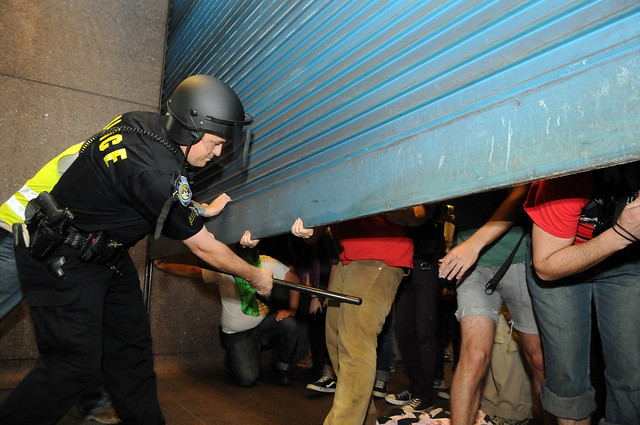
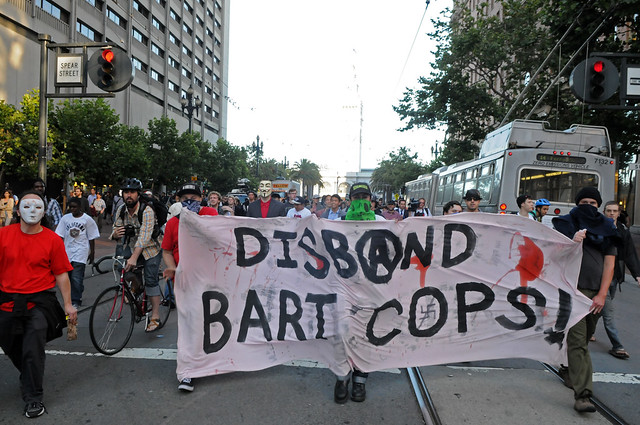
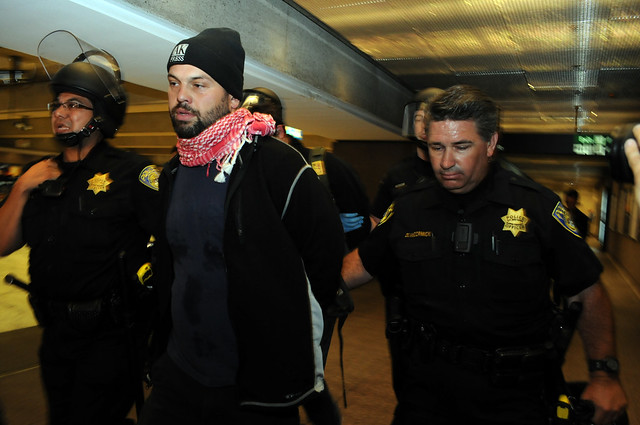
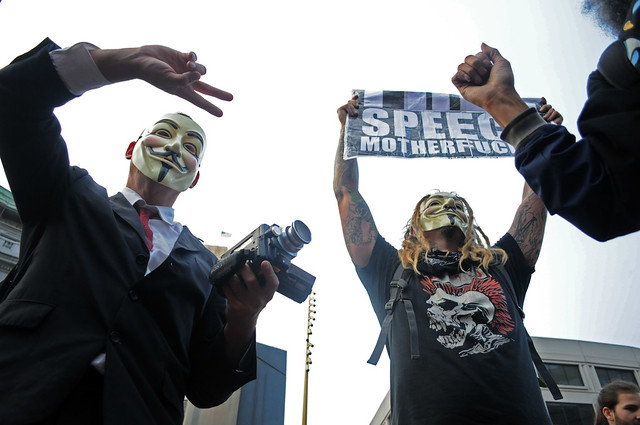 </a
</a